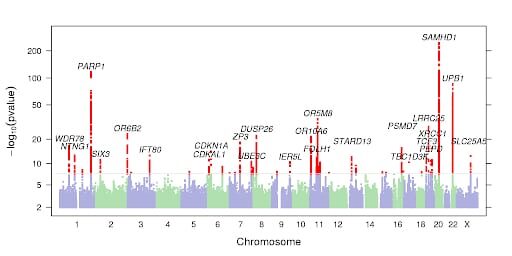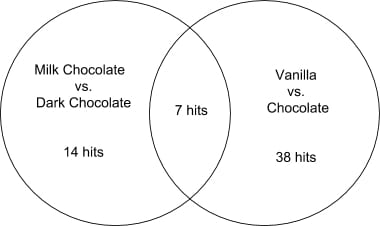By Yunru Huang, Stella Aslibekyan, Robert Gentleman*
Americans love ice cream, but some flavors more than others, and it turns out our genetics can help explain why. At an annual average of 48 pints per person, Americans consume more ice cream than any other country in the world. Approximately 86 percent of Americans eat ice cream at least once a week. Not surprisingly, the ice cream market continues growing and is anticipated to reach $10.5 billion by 2021.

Nearly 70 percent of ice cream retail purchase is driven by the flavor. While Americans are united in loving ice cream, they are strongly divided over specific flavor preferences. Most Americans prefer vanilla, followed by chocolate, with strawberry at the distant eighth place, according to a survey conducted by the International Dairy Foods Association (IDFA). How do people come by their favorite ice cream flavor? Since taste preferences are in part explained by genetics, we set out to find specific DNA sequence variants that associate with ice cream flavor preference.
To learn more about the genetics of ice cream consumption and taste preference, 23andMe researchers asked customers who consented to participate in research in June of 2018 the following questions:
- “Which of the following ice cream flavors do you like best?”
Possible answers were “vanilla”, “chocolate”, “strawberry” or “other flavors or no ice cream”.
In contrast to the IDFA survey, the majority (43.2 percent) of our research participants chose chocolate, followed closely by vanilla (37.8 percent). Only 13.2 percent of participants chose strawberry. However, this difference might be because our sample is not a random sample of the U.S. [Figure 1]. We found that women were much more likely to prefer chocolate flavor, while men favored vanilla or strawberry [Figure 2]. Older people were less likely to enjoy strawberry (P-value: 2.6*e-81). For example, people who were 68 years old were 38.5 times less likely to prefer strawberry ice cream compared to those who were 18, but the popularity of vanilla and chocolate remained steady across age groups.

Figure 1: Distribution plot of our population
We then carried out two genome-wide association studies (GWAS) of ice cream flavor preferences in our research participants of European ancestry. Because vanilla is a much more mild flavor than chocolate or strawberry, we considered it our “case.” Our first comparison was between vanilla and chocolate flavors, controlling for age, sex, ancestry, and technical artifacts. We found 45 genome-wide significant hits [Figure 3]. Many of these hits are near genes for which the biological function is not well studied. But five hits are near the gene family of olfactory receptors, which are important for smell and taste

Figure 2: Odds ratio plot illustrating flavor preference. Odds ratios greater than 1 (to the right of the dotted line) indicate a preference by women. In this case, women were much more likely to prefer chocolate flavor and men favored vanilla or strawberry.
perception, including OR6B2, OR5P3, OR10A6, OR5M3, OR5M8, OR4C13, and OR2AG2. The second GWAS compared vanilla and strawberry flavor preference, and indicated eight genome-wide significant hits, distinct from our findings of vanilla vs. chocolate flavors. However, similar to our first GWAS, the three strongest hits were also near the olfactory receptor gene family; OR5M8, OR5M11, OR6B1, OR2A5, and OR4A47 [Figure 4].
Discoveries of olfactory receptors won the Nobel Prize in Physiology or Medicine in 2004 for Richard Axel and Linda Buck. The human olfactory receptor gene family consists of approximately 800 genes, which encode almost 350 functional receptor subtypes in the nose. These receptors detect various odorants by sending signals to the olfactory bulb of the brain. The sense of taste and smell are highly associated. For example, a person can distinguish sweet and bitter flavor just via their smell, an ability that would be decreased in someone with a cold or other forms of nasal obstruction. It might be because that taste and smell both use the same type of receptors. Olfactory receptors could help activate taste receptors and then create the perception of flavor. Moreover, variation in the combinatorial olfactory receptor genes or receptors underlies sensitivities to different classes of odors, which in turn contribute to the flavor experience of foods that are processed by the corresponding taste receptors.

Figure 3. Genome-wide association study Manhattan plot for ice cream flavor preferences. Possible responses were “vanilla” (n= 86,676) or “chocolate” (n=101,833). This model treated the responses as binary variables, and adjusted for age, sex, genotyping platform, and the top 5 principal components of genetic ancestry.

Figure 4. Genome-wide association study Manhattan plot for ice cream flavor preferences. Possible responses were “vanilla” (n= 123,599) or “strawberry” (n=45,423). This model treated the responses as binary variables, and adjusted for age, sex, genotyping platform, and the top-5 principal components of genetic ancestry.
While we were not surprised to find genetic associations with taste preferences and that some were in or near genes in the olfactory receptor family, we were surprised to find that there were seven overlapping SNPs between our findings and a previous 23andMe analysis of milk vs. dark chocolate preferences [Figure 5]. For example, genetic variants associated with having a penchant for dark chocolate were also associated with liking chocolate-flavored ice cream. Meanwhile, people with genetic variants associated with preferring milk chocolate were more likely to prefer vanilla ice cream, perhaps suggesting that these variants are associated with preferring less-strong flavors.
So the next time your stomach screams for ice cream, don’t be overwhelmed by all of the choices in the dessert aisle – just let your genes lead the way.

Figure 5. Overlapping and unique GWAS results between “Milk chocolate vs. Dark chocolate” and “Vanilla vs. Chocolate”
**Robert Gentleman, Ph.D., is 23andMe’s vice president of computational biology. Yunru Huang is a scientist in Biostatistics at 23andMe, and Stella Aslibekyan is a Genetic Epidemiologist on our research team.




